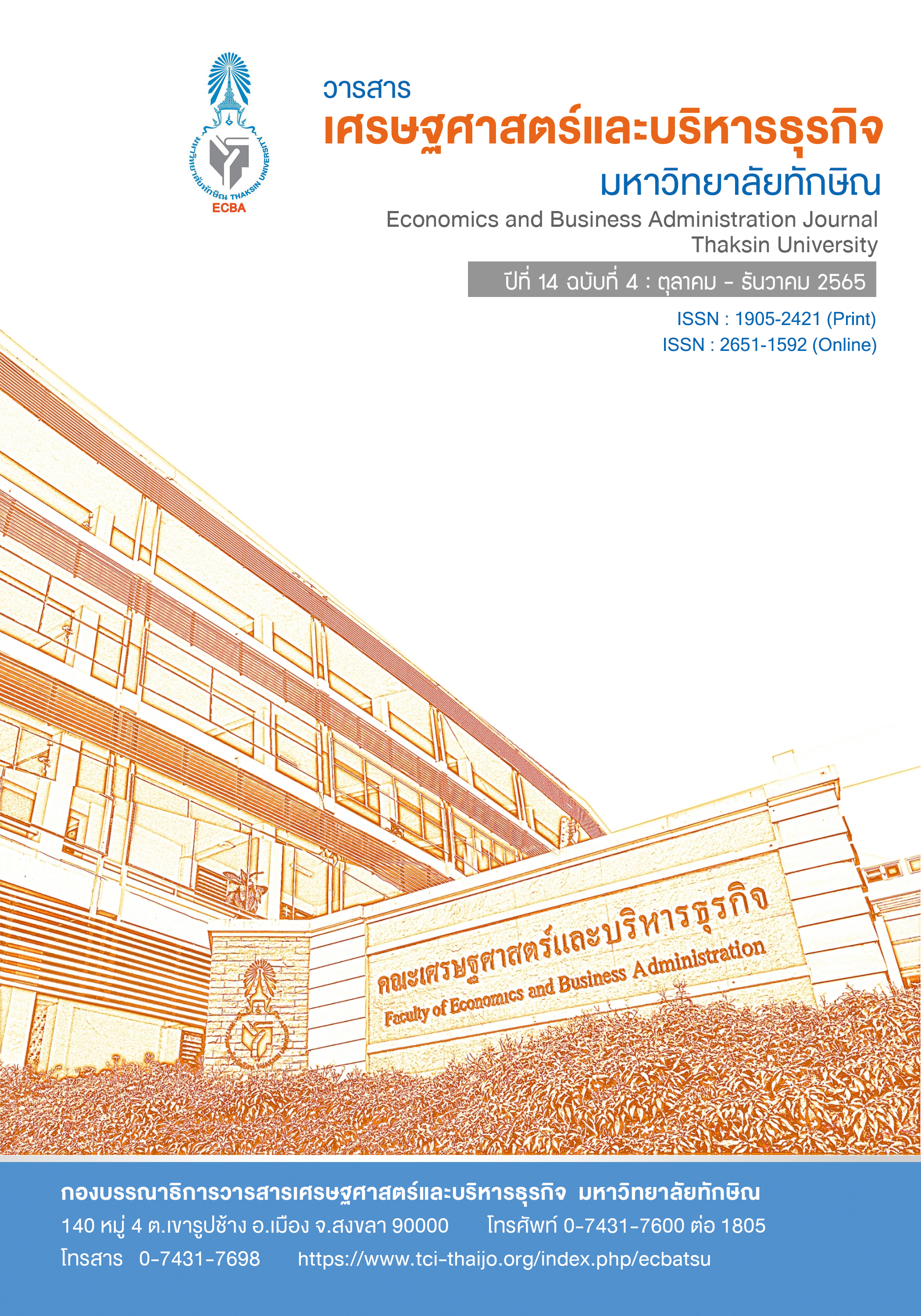Long–Run Equilibrium Relationship Between Macroeconomic Factors and Total Return (SET TRI)
Keywords:
Long-run equilibrium, Macroeconomic factor, Total returnAbstract
This research aims to study the long-run relationship between macroeconomic factors and the total return of the stock exchange of Thailand (SET Total return). Macroeconomic factors consist of Thailand’s policy rate, federal funds rate, real effective exchange rate, money supply rate, inflation rate, crude oil price, and gold price. This quantitative study gathers data on a monthly basis from January 2002 to June 2021. The ARDL-bound testing is employed in this study to examine the long-run relationship. The empirical findings reveal that the federal funds rate, real effective exchange rate, and crude oil price are all positively related to SET total return in the long run. On the other hand, Thailand's policy rate is negatively related to SET total return in the long run. Furthermore,
the validity of forecasts determined by using Root Mean Squared Error and Theil Inequality Coefficient shows that security analysts or investors can use the empirical result that forecasts total return (SET TRI) for long-term investment planning, such as ETF or index fund.
References
Abed, R. E., & Zardoub, A. (2019). Exploring the nexus between macroeconomic variables and stock market returns on Germany: An ARDL Co-integration approach. Theoretical and Applied Economics, 2(619), 139-148.
Akinwande, M.O., Dikko, H.G., & Samson, A. (2015). Variance inflation factor: As a condition for the inclusion of suppressor variable(s) in regression analysis. Open Journal of Statistics, 15(5), 754-767.
Al-hajj, E., Al-Mulali, U., & Solarin, S.A. (2018). Oil price shocks and stock returns nexus for Malaysia: Fresh evidence from nonlinear ARDL test. Energy Reports, 4, 624-637.
Bank of Thailand. (2014). Real Effective Exchange Rate. Retrieved from https://www.bot.or.th/Thai/FinancialMarkets/ForeignExchangeMarket/RelatedArticles/DocLib_ExchangeRateKnowledge/ FAQ_86.pdf.
Chaiwan, A., & Srijan, N. (2013). The impacts of economic variables on the small and medium enterprise stock exchanges in Southeast Asian countries. Chiang Mai University Journal of Economics, 18(2), 4-20.
Chia, R., & Lim, S. (2015). Malaysian stock price and macroeconomic variables: Autoregressive Distributed Lag (ADRL) bounds test. Kajian Malaysia, 15(33), 85-103.
Devkota, T.P., & Dhungana, A. (2019). Impact of macro-economic variables on stock market in Nepal: An ARDL approach. The Journal of Economic Concerns, 10(1), 47-64.
Humpe, A., & Mcmillan, D. G. (2020). Macroeconomic variables and long-term stock market performance. A panel ARDL cointegration approach for G7 countries. Cogent Economic & Finance, 8(1), 1-7.
Joshi, P., & Giri, A.K. (2015). Dynamic relations between macroeconomic variables and Indian stock price: An application of ARDL bounds testing approach, Asian Economic and Financial Review, 5(10), 1119-1133.
Kanjananantawong, T., & Vichitthamaros, P. (2016). Rate of return and risk analysis of the insurance securities using arbitrage pricing theory model. WMS Journal of Management Walailak University, 5(2), 1-11.
Khan, M.K., Teng, J., & Khan, M.I. (2019). Asymmetric impact of oil prices on stock returns in Shanghai Stock Exchange: Evidence from asymmetric ARDL model. PLOS ONE, 14(6), 1-14.
Kolapo, F.T., Oke, M.O., & Olaniyan, T.O. (2018). Unravelling the impact of macroeconomic fundamentals on stock market performance in Nigeria: An ARDL-bound testing approach. Journal of Economics, Management and Trade, 21(3), 1-15.
Mekvatana, K., & Rangkakulnuwat, P. (2017). Long-run relationship between personal housing loan and economic growth. Applied Economics Journal, 24(1), 38-59.
Pesaran, H., Shin, Y., & Smith, R. (2001). Bounds testing approaches to the analysis of level relationships. Journal of Applied Econometrics, 16(1), 289-326.
Rangkakulnuwat, P., & Thaweekhot, N. (2020). Long-run equilibrium between the banking stock price index and macroeconomic and financial variables: ARDL approach. NIDA Business Journal, 20(26), 130-152.
Raza, N., Shahzad, S.J.H., & Tiwari, A.K. (2016), Asymmetric impact of gold, oil prices and their volatilities on stock prices of emerging markets. Resources Policy, 49, 209-301.
Ross, S. (1976). The arbitrage theory of capital asset pricing. Journal of Economic Theory, 13(1), 341-360.
Savasa, B., & Samiloglub, F. (2010). The Impact of macroeconomic variables on stock return in Turkey: An ARDL bounds testing approach. Afyon Kocatepe Universitesi, 12(1), 111-122.
Sharpe, W. (1964). Capital asset prices: A theory of market equilibrium under conditions of risk. Journal of Finance, 19(3), 425-442.
Somnuek, S., & Kokong, P. (2016). The relationship between macroeconomic factors and returns in Thailand stock exchange. Research report, Burapha University, Chon Buri, Thailand.
The stock exchange of Thailand. (2019). Total return index. [Online]. Retrieved January 8, 2021 from https://www.set.or.th/en/products/index/tri_p1.html.
Tripathi, V., & Kumar, A. (2015). Do macroeconomic variables affect stock returns in BRICS markets? An ARDL approach. Journal of Commerce & Accounting Research, 4(2), 1-15.
Tursoy, T., & Faisal, F. (2018). The impact of gold and crude oil prices on stock market in Turkey: Empirical evidences from ARDL bounds test and combined cointegration, Resources Policy, 55(1), 49-54.
Downloads
Published
How to Cite
Issue
Section
License
Copyright (c) 2022 Economics and Business Administration Journal Thaksin University

This work is licensed under a Creative Commons Attribution-NonCommercial-NoDerivatives 4.0 International License.




